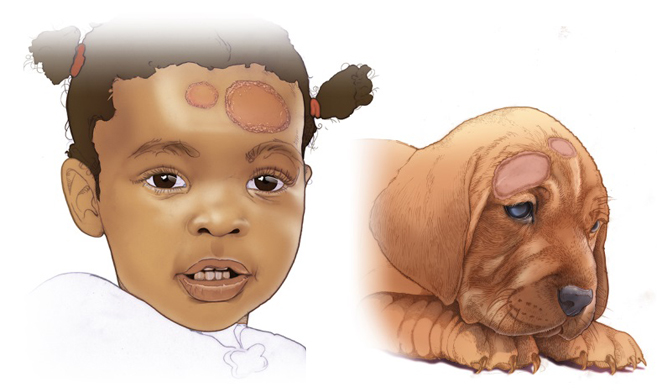Fungus Common Cause of Ringworm in Pets

Ringworm is one of the few diseases that can be transferred from pets to humans, and occasionally vice versa. It is a fungus disease of the skin which has nothing to do with a worm parasite, but which gets its name from the rounded lesions that it produces in the skin of humans and some animals.
The most common cause of ringworm in cats and dogs is the fungus Microsporum canis. This is also highly infectious to humans. A common sequence of events is that the newly acquired kitten or puppy is brought to the veterinary surgeon because some members of the family have suddenly developed irritating, red, ringlike lesions on the arms, neck or face. Often the animal has been a stray or has been acquired from a fete or petshop.
In kittens, signs of ringworm can be difficult to detect. The fungus produces very little reaction in the skin of the cat. Sometimes the hair in the affected area has a singed appearance and if the skin surrounding the whiskers is affected, the whiskers may break.
The fungus invasion of the skin produces more reaction in a dog’s skin. Raised circular areas, devoid of hair, appear around the muzzle and on the legs. Secondary infection is quite common and the affected area may be covered with a thick crust of exudate.
Diagnosis of Microsporum canis infection in dogs and cats is made easier because of a property that the fungus exhibits when exposed to ultraviolet light.
Infected areas emit a greenish fluorescence when examined in the dark with an ultraviolet lamp. Very small affected areas are able to be detected as even the fluorescence from infected hair is easily seen.
The incubation period is variable. It may be as short as two weeks between the introduction of an infected animal and the appearance of lesions in the family or on other animals in the household. Fungal spores shed from the skin and hair of the animal contaminate chairs, carpets and bedding.
Direct contact with the fungal elements on the skin of the animal is probably responsible for the rapid spread to the face and arms of the members of the family who pet the newcomer.
Fortunately, modern treatment does not rely on the application of messy ointments and paints to the skin of the unfortunate patient. Griseofulvin in tablet form is taken by mouth and is active against the fungus in the skin.
This is administered after thorough clipping of the area to physically remove as much of the affected material as possible. Treatment is maintained over a period of weeks and progress is assessed by regular examinations of the animal under an ultraviolet lamp.
A fungicidal wash is also useful at the same time, as this reduces contamination of the animal’s surroundings and the risk of infection to humans and other pets.
Of course, the bedding should be changed frequently and care should be taken to prevent the infected animal from getting on to beds, carpets and chair covers.
Because of the difficulty in detecting ringworm in kittens, particularly in long-haired varieties, it is wise to get your veterinarian to check any new introductions.
Author Bio :
A health-beauty expert, and Lifestyle & Wellness blogger from Los Angeles. She’s happy to share her health and beauty secrets.
Akshay Sharma
Latest posts by Akshay Sharma (see all)
- 7 Tips for Finding Affordable Linen Sheets in the UK - April 19, 2024
- Baby Products You Should Own - March 8, 2024
- Unveiling the Role of a Buyers Agent: Demystifying Real Estate Transactions - March 8, 2024
- Discover Dubai: The Top Places to Visit for an Unforgettable Trip - February 26, 2024
- The Future of Healthcare Communication: Mailing Services in the Digital Age - February 23, 2024
